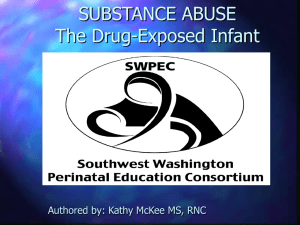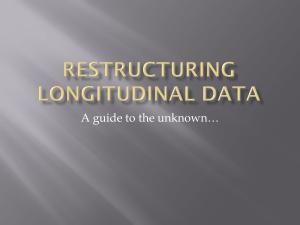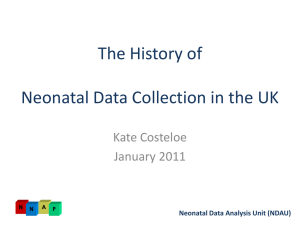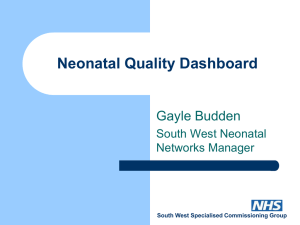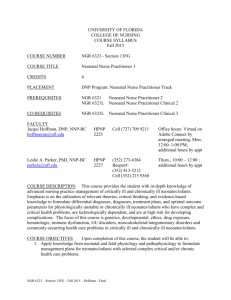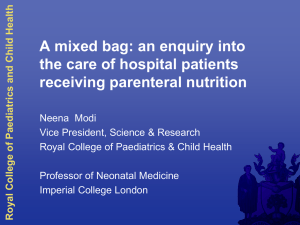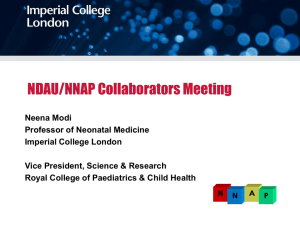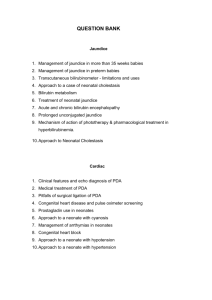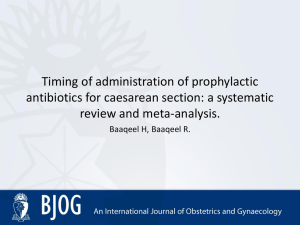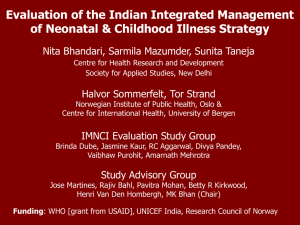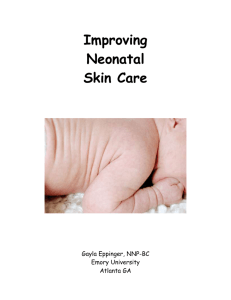Recognizing sources of neonatal pain…
advertisement
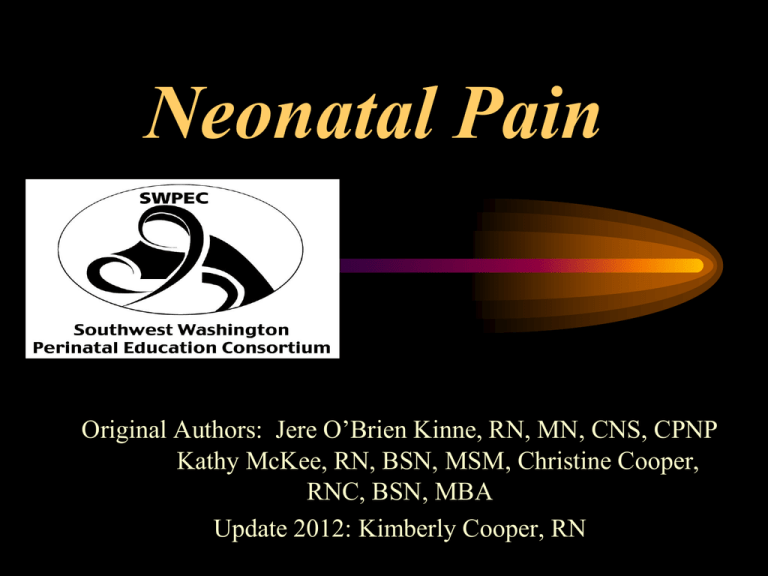
Neonatal Pain Original Authors: Jere O’Brien Kinne, RN, MN, CNS, CPNP Kathy McKee, RN, BSN, MSM, Christine Cooper, RNC, BSN, MBA Update 2012: Kimberly Cooper, RN What is Pain? • Pain: “an unpleasant sensory or emotional experience associated with actual or potential tissue damage” • The inability to communicate the feeling of pain in no way negates the possibility that an individual is experiencing it. Pain Assessment & Treatment Background… • For decades, pain management for infants was essentially non-existent, and various procedures (including surgery) were performed with paralytics and minimal analgesics. Jeffery Lawson’s Story Jeffrey had holes cut on both sides of his neck, another cut in his right chest, an incision from his breastbone around to his backbone, his ribs pried apart, and an extra artery near his heart tied off. This was topped off with another hole cut in his left side for a chest tube. This operation lasted hours. Jeffrey was awake through it all. The anesthesiologist paralyzed him with Pavulon, which left him unable to move but totally conscious. When the anesthesiologist was questioned about her use of Pavulon, she said Jeffrey was too sick to tolerate powerful anesthetics and that it had never been demonstrated to her that premature babies feel pain. Jeffrey died a month after surgery. His mother later reviewed her child’s medical chart and found that at no point during the surgery had her son had anesthesia. She began an impassioned crusade to change the practice of lack of anesthesia in neonatal surgery. This story led to the examination of and changes in neonatal pain practice in the United States. Jeffry’s Legacy • In 1986 into the 1990’s studies showed that newborns do feel pain, remember pain, and can safely be given anesthesia and analgesia. • Many professional organizations (including the AAP, the Joint Commission of Accreditation of Healthcare Organizations, and NANN) have mandated pain treatment for newborns. • Today, pain is considered “the 5th vital sign” • In 1999 JCAHO mandated standards for pain assessment and management. Hospitals had to comply by January 2001. In 2013, pain management continues to be a global issue. Golden Rule of Pain: • “What is painful to an adult is painful to an infant, unless proven otherwise.” Myth • Neonates don’t feel pain Facts • Research has shown that a 20-22 week fetus has complete pain pathways and the ability to experience pain. • The youngest premature infant has the anatomic and physiologic components to perceive pain and demonstrates a severe stress response to painful stimuli. Facts • Complete myelination of nerve pathways not required for pain transmission • Incomplete myelination results in slower conduction velocity but is offset by shorter distances • In fact, pain might actually be exaggerated due to the unmyelinated fibers and immature modulating capabilities of developing nervous systems Facts • The threshold for responding to cutaneous stimulation is lowest in youngest neonates. • Inhibitory pathways do not develop until after birth. • Babies’ tolerance to pain actually INCREASES with age. Effect of GA on HR Response Change in HR (BPM) (tested at >36 weeks of life) 40 35 Stimulus 30 25 20 Mild 15 Moderate 10 High 5 0 -5 <28Wks 28-32 Wks 32-36 Wks >36 Wks Porter, et al. Pediatrics, 1999 Myth • Newborns can’t remember pain Facts • Unrelieved pain in infants can permanently change their nervous system and may “prime” them for having chronic pain. • When sensitized, receptors respond to new forms of stimulation, eg, hyperalgesia. • Long-term potentiation – cellular “memory” for pain may lead to increased receptor sensitivity. Myth • Neonates don’t react to pain Facts Physiologic Signs of Pain in the Neonate: • shallow respirations • HR, RR, BP • vagal nerve tone (shrill cry) • pallor or flushing • diaphoresis, palmar sweating • TcPO2 and O2 saturation • EEG changes Facts Biochemical changes associated with Pain include: • stress hormones (corticosterone, adrenaline, noradrenaline, glucagon, aldosterone) • Metabolites (glucose, lactate, pyruvate) Myth • Analgesics are not safe to give to neonates Facts • Narcotics are no more dangerous for children than adults. • Addiction from narcotics (opioids) used to treat pain is extremely rare in adults; no reports substantiate this fear in children; reports of respiratory depression in children are rare. Myths Assessing neonates for pain is impossible & Pain is a subjective experience that cannot be communicated by neonate Fact: There are several validated pain assessment tools for neonates Observations • Facial Expression (most reliable sign) • Vocalization • Body Language • Emotional State Facial Expression • Eyes tightly closed or opened • Mouth opened, squarish • Furrowing or bulging brow • Quivering of chin • Deepened nasolabial fold The “eyes” have it… Possible Behavioral Signs of Pain in the Neonate Vocalizations: • Crying (often with apneic spells) • Whimpering, groaning, moaning Body Language •Changes in sleep/wake/activity •Agitation or listlessness •Limb withdrawal/swiping/thrashing •Rigidity •Flaccidity •Clenching of fists Evidence-based guidelines for the management of neonatal pain • Recognize the sources of pain • Investigators found infants in a NICU were exposed to up to 53 painful procedures/day. The investigators indicated also that ~40% of all neonates did not receive any analgesia at all during the intensive care stay. Recognizing sources of neonatal pain… Recognizing sources of neonatal pain… Diagnostic: Art stick, Bronchoscopy, Endoscopy, Heel Stick, LP, ROP Exam, Bladder Tap, Venipuncture Therapeutic: Bladder Catheterization, Central Line Placement, Chest Tubes, Chest PT, Dressing Change, Gavage Tube Insertion, Injections, Mechanical Ventilation, Tape Removal, Suture Removal, Tracheal Intubation/Extubation, Tracheal Suctioning, Ventrical Tap Surgical: Circumcision, other Surgical Procedures Recognizing sources of neonatal pain… •The low risk nursery has many of the same noxious (and pleasant) stimuli found in the high risk nursery. •However, a healthy near- or full-term baby is much better equipped to manage new stressors than their sick counterparts. Recognizing sources of neonatal pain… • Environment is a key factor affecting the neonate’s development. • It is the nurse’s responsibility to minimize noxious stimuli to facilitate optimal outcomes. Take Cause of Pain into Account Use common sense and logic. Realize that for an infant, punctures are proportionally larger on their bodies. Strategies to Minimize Pain • Time blood draws to include as many tests as possible to reduce the number of needle punctures. • Use line draws whenever possible. • Avoid invasive monitoring whenever possible. • Use minimal amount of tape and remove tape gently. • Ensure proper premedication before invasive procedures. • Use appropriate equipment. Pain Management • Non-Pharmacological – Goal • Relieve pain when it is expected to be of short duration • Pharmacological – Goal • Control the pain as fast as possible with the lowest effective dose Non-Pharmacological • Positive Touch • Kangaroo Care • Non-nutritive sucking • Sucrose Pharmacological • • • • • Morphine Fentanyl Lidocaine EMLA Acetaminophen Differentiating Agitation & Pain Pain Assessment Tools • NIPS (Neonatal Infant Pain Scale) (Recommended for children less than 1 year old) (adapted from the CHEOPS scale) • CRIES (32-60 weeks gestational age) (Kretchel & Bildner, 1995) • NPASS (Neonatal Pain, Agitation and Sedation Scale) (prematurity) (Hummel & Puchalski, 2002) • FLACC (full term neonate – 7 years) (Merkel & others, 1997) • PIPP (Premature Infant Pain Profile) (Stevens B Johnston C et al., 1996) Neonatal Infant Pain Scale (NIPS) CRIES NPASS (Neonatal Pain, Agitation and Sedation Scale) FLACC Premature Infant Pain Profile • Facial: – Brow bulge – Eye squeeze – Nasolabial furrow • Physiological: – Heart rate – Oxygen saturation • Context – Gestational age – Behavioral state • Inter-rater reliability >.93 Take action. Assess effectiveness. The only reason to assess pain is TO TAKE ACTION TO RELIEVE PAIN. After intervention, assess child’s response to pain relief measures. Determine timing of assessment based on expected onset and peak effect of intervention: IV analgesic: assess after 5 minutes and 15 minutes Recommendations • Advocate for infants if they are exhibiting pain cues • Integrate research studies and research findings into practice • Develop hospital protocols to provide fair and effective pain control to neonates Heel Sticks IV Insertion Intubation “How sweet for those faring badly to forget their misfortunes for even a short time.” --- Sophocles References Adamkin, David, et al. (2006) Prevention and management of neonatal pain. Pediatrics Vol. 118 No. 5 November 1, 2006 pp. 2231 -2241 (doi: 10.1542/peds.2006-2277. Anand, K.J.S. (2007) Pain assessment in preterm neonates. Pediatrics Vol. 119 No. 3 March 1, 2007 pp. 605 -607 (doi: 10.1542/peds.2006-2723) Beacham, Pamela S. (2004). Behavioral and physiological indicators of procedural and postoperative pain in high-risk infants. JOGNN, 33 (2), 246-255. Broome, Marion E. & Tanzillo, Heidi (1990). Differentiating between pain and agitation in premature neonates. Journal of Perinatal and Neonatal Nursing, 4 (1), 53-62. Cunningham, Nance (1990). Ethical perspectives on the perception and treatment of neonatal pain. Journal of Perinatal and Neonatal Nursing, 4 (1), 75-83. Gallo, Ana-Maria (2003). The fifth vital sign: Implementation of the Neonatal Infant Pain Scale. JOGNN, 32 (2), 199206. Noerr, Barbara (2001). Sucrose for neonatal procedural pain. Neonatal Network, 20 (7), 63-67. Puchalski, Mary & Hummel, Pat (2002). The reality of neonatal pain. Advances in Neonatal Care, 2 (5), 233-247. Reyes, Sarah (2003). Nursing assessment of infant pain. Journal of Perinatal and Neonatal Nursing, 17 (4), 291-303. Walden, Marlene & Gibbins, Sharyn(2008). Pain Assessment and Management: Guideline for Practice. Second edition. National Association of Neonatal Nurses. (Bozzette, 1993; Franck, 1986, 1998; Fuller, 1991; Grunau & Craig, 1987; Grunau et al., 1999; Johnston, Stevens, Yang, & Horton, 1995; Levine & Gordon, 1982; Porter, Miller, & Marshall, 1986; Stevens, Johnston, & Horton, 1993, 1994) Prevention and management of neonatal pain • Reprinted with permission from Elsevier from Gardner, S. L., Hagedorn, M. I. E., & Dickey, L. A. (2006). • Pain and pain relief. In G. B. Merenstein & S. L. Gardner, Eds., Handbook of neonatal intensive care, 7th • Ed., 2011. Table 12-4 p. 2438 Thank you for all you do…
